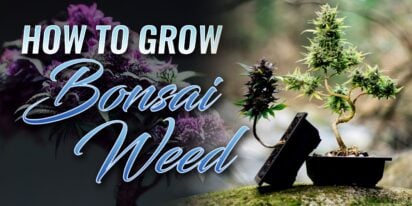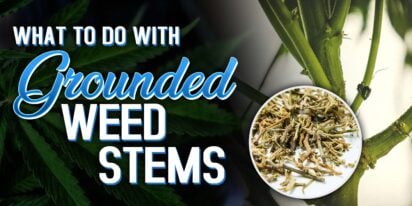
Are You 18 Or Over?
YesOr
No By clicking yes, you certify that you are over 18. By using this website, you agree to our legal disclaimer.605+ Cannabis Strains over 20 Breeders worldwide.
Table of Contents

Sexing a marijuana plant is to know the gender of your plants as they enter the flowering stage. Knowing which of your plants is male or female is important to the overall yield of your grow room.
How can you sex your cannabis plants? Let us answer this question by looking at the identifying traits of a plants gender and explain the significance of male, female, and hermaphrodite plants.
It is important to note that every regular and autoflower Cannabis Seeds have a chance to grow into a male or female plant. The plant’s gender will become apparent when it enters the flowering cycle. At this time, their sex organs will grow and gain the characteristics of either a male or female plant.
The key word when it comes to spotting a female plant is hair. This plant will grow buds that have a pair of white hair or pistils sprouting from the top. In addition, the pistils and upper part of the bud will have tiny hair sprouting around it.
On the other hand, male plants will grow bulbous pollen sacs. The shape of these sacs is the same as the ones with the buds. However, these buds will only appear to grow big over time and not have a pair of pistils coming out at the top. The sex organs will also have no small hair surrounding the top like the female sex organ.
You may encounter a plant that will have both male and female sex organs. This type of plant is a hermaphrodite and is a common phenomenon among cannabis plants. For all intents and purposes, most herm plants are treated as male plants. What is interesting to note is the shape of a hermaphrodite’s male organ, which looks elongated instead of being round. This is why breeders call the flowers bananas.
While waiting for your plants to develop its sex organs is the tried and true way of identifying their gender, some breeders find signs of a plant’s gender throughout its growth cycle. One method is to check on the growth pattern of the plants.
Male cannabis plants usually grow taller than female plants and have a thicker central stalk. The thick stalk trait is to provide more support to the top of male plants. In addition, males usually have fewer branches and leaves than female plants. Meanwhile, female plants have thin central stalks and complex branches full of numerous leaves.
Some breeders found a way to identify a seed’s sex during the germination period. If the taproot shoots out of the sides of a seed, it may turn into a male plant. Should the seed grow its taproot from its top or bottom, it may grow to a female plant.
Take note that the two methods in identifying a plant’s sex are not accurate. Do not take out a plant from your garden right away if it has a thick central stalk than other plants or its taproot sprouted from the side. The plant may still turn to a female one when it enters the flowering stage. What you can do instead is to mark the plants that have early characteristics of male plants. When your plants enter the flowering period, you can give the marked plants a close check for any production of pollen sacs on their branch joints.
A sure-fire method is to create clones from the plant and allow it to go through the vegetative phase in a short time. This method involves cutting a sizable part of your plant and allow it to grow in a medium. When the clone grows into a plant in a few days, expose it to a 12/12 daylight to nighttime schedule. This will force the plant to enter the flowering phase and show its gender earlier than the mother plant.
The method works because clones have the same traits and genetics as the mother. This also includes the gender of the mother plant. In order to perform this test, you will need a separate indoor grow area with a grow lamp. This will let you expose only the clones to the 12/12 lighting schedule. It is also important to label the clones and the mothers to avoid any confusion once the clone shows its sex organs.
The main difference between the three types of the plant comes down to the bud producers and pollen makers. Female plants are your former type of plant while males and hermaphrodites make up the latter. If you are only looking to cultivate cannabis plants for their high-inducing buds, you will only want to have female plants within your garden.
You might be asking if the pollen sac of male plants are consumable or can still be smoked. To answer your question, the sac is consumable. However, it will not have the same psychoactive effect or potency as the buds from female plants. Only female plants produce a significant amount of cannabinoid that is equal to their strain. Cannabinoids such as THC and CBN are responsible for a marijuana weed’s effect. Unfortunately, male plants do not produce the same amount of cannabinoids as its female counterpart.
Hermaphrodites are slightly complicated in a way that it can still produce the same type of bud as its female counterpart. This is only possible if there are a few male flowers and more female buds surrounding the plant. Should this be the case, you can extract the male bananas with a tweezer coated in rubbing alcohol. Upon cutting the organ, spray the flowering area with water to remove the pollen. Continue monitoring the plant for any male organs to sprout out of it. If a herm plant happens to have too many bananas and few buds, consider discarding it or harvest its pollen in a separate room.
As soon as you find any male or herm plants in the garden, you will want to discard or place the plants in a room that is away from the rest of your female plants. Allowing even one male or herm plant in your grow space can lead to unwanted fertilization of the female ones. Pollinated female plants will stop building up its buds with various cannabinoids. Instead, it will focus all of its energy on producing seeds within its buds.
Unless you are looking forward to creating a batch of seed for a specific strain, you will want to separate the females from pollen producing plants right away. This is not to say that it is not worth your while to make your own seed from your favorite strain. However, there is an efficient way of producing seeds and buds at the same time. It is important to note that a single female plant can give you more than 20 seeds when pollinated. Simply allowing male plants to pollinate all of your bud-producing females will be a waste of your time and effort.
You have no control over the gender of a regular seed, including autoflowering ones. They will grow into a male or female plant regardless of the type of nutrient you feed them or how you germinate the seeds. If you want to nearly all of the seeds to turn female, you can move the odds to your favor by cultivating feminized seeds instead of regular ones. Feminized seeds have the genetic coding to grow into a female plant because it has two mothers.
While feminized seeds are available in most seed banks, you will often find fem seeds for popular strains. Fortunately, you can make your own batch of feminized seeds for your favorite strains. To do this, you need to chemically force a female plant to become a hermaphrodite.
Before attempting to turn a plant into a herm, you need a separate grow room to cultivate the designated plant that will produce the pollen. Accidental pollinations are not the only reason to separate a designated herm plant from the rest of your female plants. The reason is more on your safety as well as the health of anyone who will smoke your marijuana strain. This is due to our use of colloidal silver to make our herm plant.
Colloidal silver is small particles of silver floating around a solution of water. It is important to note that the substance is not toxic since people drink them as a nutrient supplement. However, marijuana strains that are exposed to colloidal silver become unsafe. On the other hand, the pollen from a herm plant that will go through the chemical process will be safe to use on other female plants.
When the designated female plant enters the flowering phase, spray the flowering site of the plant once a day with colloidal silver. Make sure to pick a bottle that has at least 30 PPM of silver. Keep spraying the plant for a period of two to three weeks. You will soon see the plant grow pollen sac on its flowering site. Continue applying the substance until the sac looks like it is full of pollen.
Collect the pollen and store it in a sealable bag. Allow the sac to dry so you can easily free the pollen from its confine. Place another designated female plant to produce the seeds in a separate growth room. Apply the pollen to the calyx of the plant with either a paintbrush or cotton bud. You should see the calyx bulge in size over time. In six weeks after pollinating the calyx, the seeds should be ready for harvest.
Another method of producing a herm plant without the use of colloidal silver is through the Rodelization process. The method is simple since it involves allowing the female plant to flower beyond the peak harvest point. This triggers the female plant’s natural instinct to protect the next generation by growing its own pollen sacs in order to pollinate its buds.
When the pollen sac of the female plant appears to be ready to crack open, collect it with a sealable bag and store it for future female plants. Because this method involves the creation of pollen, it is advisable to have the designated female plant to flower in a separate room to avoid accidental fertilization.
The main issue with the Rodelization process is how the seeds it produces may become regular ones. Female plants that grow male characteristics tend to provide a gene that makes its offspring grow male traits. In addition, female plants may not grow pollen sacs as it continues to flower after the peak harvest point. Even if they do produce pollen, the amount you get is significantly less than herm plants that went through the colloidal silver treatment.
Apart from genetics, female plants can turn into hermaphrodites if they are under severe stress due to environmental factors. This includes exposing the plant to an excessive amount of heat, which can occur during summer or placing HID lamps too close to the plants.
Physical damages can also stress out female plants to turn into a herm. This type of damages includes over pruning the plant or taking a large cutting for cloning purposes. Seedlings are also easy to stress out when transferring them from two different containers. Doing so can aggravate the roots of young plants.
Failing to water the plant regularly or preventing the medium from drying can also lead to stress. Lack of water can stunt the growth development of the plant and make it think that it is in danger.
Pests are another factor of hermaphroditism because they can aggravate the plant’s structure. In addition, use of potent pesticides on the plant to control an infestation of insect can also have the same negative effect.
Overall, you can avoid growing hermaphrodites by practicing proper cultivation ethics. This includes providing the plants with proper air ventilation or circulation to keep it cool in any environment. Another is to sanitize its surrounding to lower the chances of a pest infestation.
You now know the best way to sexing marijuana plants as well as differentiate between the three genders. Separate the male and hermaphrodite plants from the rest of your growing garden to prevent any of your buds to turn into seeds. If you want to produce your own seeds, cultivate the male or hermaphrodite plant in a sealed room to prevent any pollen from reaching your female plants.

In recent years, the discourse surrounding secondhand marijuana smoke has gained significant attention, paralleling the legalization and increas

In the realm of cannabis culture, the practice of "wake and bake" holds a significant place, accompanied by both supporters and skeptics. As exp

Introducing the robust indica strain known as Critical Mass weed, a harmonious fusion of Afghani and Skunk #1 genetics. Delve into its essence,

Fusarium wilt cannabis represents a significant threat to cannabis cultivation, necessitating a comprehensive understanding of its intricacies.

1980s were a time of profound cultural transformation, marked by iconic fashion, music, and movies. Alongside these trends, a unique facet of '8

[ez-toc] In the deep history of cannabis cultivation, there exists a captivating and creative practice that combines the art of cultivation wit

For growers looking to get better yields and healthier cannabis plants, it's important to understand and control the cannabis soil pH levels. pH

[ez-toc] In indoor gardening, maintaining an optimal temperature within your grow tent is crucial for the health and productivity of your plant

[ez-toc] Welcome to the delightful world of cannafudge crafting, where sweetness meets sophistication, and cannabis infusion adds a unique twis

[ez-toc] You’ve finished trimming your weed, but what about those leftover stems? Don’t throw them away! These seemingly useless bits can a

Are You 18 Or Over?
YesOr
No By clicking yes, you certify that you are over 18. By using this website, you agree to our legal disclaimer.